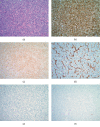Primary Intraosseous Synovial Sarcoma with Molecular Confirmation: Expanding and Clarifying the Spectrum of This Rare Neoplasm
- PMID: 32082672
- PMCID: PMC7011484
- DOI: 10.1155/2020/5492754
Primary Intraosseous Synovial Sarcoma with Molecular Confirmation: Expanding and Clarifying the Spectrum of This Rare Neoplasm
Abstract
Synovial sarcoma is a well-known malignant tumor usually originating within deep soft tissues of the lower extremities of adolescents and young adults. Rare radiologically confirmed examples of primary bone synovial sarcoma have been documented, generally in isolated case reports. Herein, we report two cases of primary intraosseous synovial sarcoma, with molecular confirmation, involving the left humerus of a 45-year-old female and the right fourth metatarsal bone in a 36-year-old male. Additionally, we clarify the spectrum of primary intraosseous synovial sarcoma by separately analyzing reported cases with radiographic confirmation of bone origin and molecular support for the diagnosis. There are clinicopathologic differences between those tumors with documented molecular confirmation and those lacking such confirmation, specifically regarding their anatomic distribution (p < 0.0001). Regarding the radiology of our two cases, the humeral lesion appeared almost entirely intramedullary without soft tissue extension; the midfoot lesion demonstrated a destructive, metatarsal-centered bone lesion, initially thought clinically to represent primary bone osteosarcoma. The diagnoses of monophasic synovial sarcoma were rendered via core needle biopsies, with molecular FISH confirmation of SYT gene rearrangement. Clinical follow-up data was only available for the female patient with the primary humeral lesion, who underwent surgical resection, with no local recurrence or distant metastasis at 7 months postsurgery. To our knowledge, these are the first reported examples of molecularly confirmed, primary intraosseous synovial sarcomas of the humerus and metatarsal bones. Primary intraosseous synovial sarcomas with molecular confirmation differ clinically from those lacking it; however, the demographic features and metastatic potential appear similar to primary soft tissue synovial sarcoma.
Copyright © 2020 Kelsey E. McHugh et al.
Conflict of interest statement
The authors declare that there are no conflicts of interest regarding the publication of this paper.
Figures








References
-
- Goldblum J. R., Weiss S. W., Folpe A. L. Enzinger and Weiss’s Soft Tissue Tumors. Saunders; 2013. Synovial sarcoma; pp. P1052–P1070.
Publication types
LinkOut - more resources
Full Text Sources

